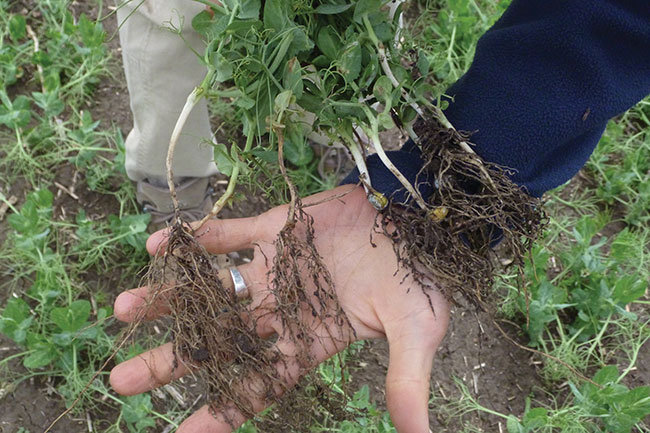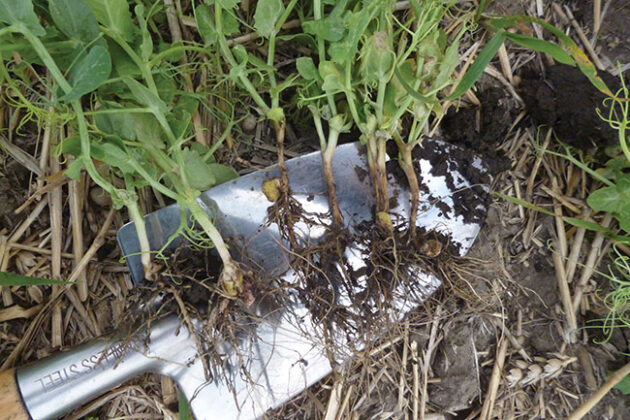
Features
Diseases
Pulses
Aphanomyces app guides pulse rotations
Aphanomyces Risk Evaluation app developed to help assess disease risk.
October 25, 2023 By Bruce Barker
 Aphanomyces root rot infect pea roots (left) compared to healthy roots (right).
Photos courtesy of Sherrilyn Phelps
Aphanomyces root rot infect pea roots (left) compared to healthy roots (right).
Photos courtesy of Sherrilyn Phelps A phanomyces root rot can be a devastating disease on several host pulse crops, with peas and lentils being the most susceptible. Currently, there is no reliable prevention or cure, and a long crop rotation of six to eight years is recommended to minimize the disease’s impact. The new Aphanomyces Risk Evaluation App was developed to help farmers understand their risk based on past rotations and other agronomic and environmental factors.
“The objective of the app is to develop a publicly available tool that allows growers and agronomists to identify the risk of Aphanomyces root rot for individual fields in Saskatchewan,” says Sherrilyn Phelps, director of research and development with Saskatchewan Pulse Growers. “One of our long-term strategies is mitigating the risk of root rots in peas and lentils, and this app provides a tool for growers and agronomists to better predict the risk of Aphanomyces in fields before planting peas or lentils in those fields.”
The app was developed by the Agronomic Crop Imaging Lab in the Department of Plant Science at the University of Saskatchewan, in collaboration with the Interaction Lab at U of S. Funding for the development was provided by Sask Pulse.
“We got involved with research using the Google Earth engine and were able to put together a way of looking at crop rotations over time and the frequency of pulse crops grown in rotation in Saskatchewan,” says Steve Shirtliffe, a plant science professor at U of S who led the app’s development.
The app incorporates crop history and weather when pulses were grown to produce maps identifying the risk level on a field-by-field basis.
Cropping information comes from Agriculture and Agri-Food Canada’s Annual Crop Inventory, licensed under the Open Government Licence – Canada, version 2.0. Crop type is determined by AAFC using remotely sensed satellite imagery with an accuracy of more than 90 per cent. Precipitation data was generated using Copernicus Climate Change Service information.

Health pea roots (left) compared to Aphanomyces root rot peas (right).
“We didn’t create any data. We simply used publicly available data that was free to use,” says Shirtliffe.
The app is currently desktop-based, but Shirtliffe says they are working on optimizing the web-based app for better use on mobile devices. No stand-alone app is planned because the data integration and future updates are massive and rely on cloud storage.
When the app is opened on the desktop, a map of Saskatchewan is displayed. Growers can zoom in to select an area of interest and then choose one of their fields for assessment. A pop-up asks what crop was grown in the past year, and then a risk level for Aphanomyces is displayed, along with field crop history and May-June precipitation going back to 2009.
The app went live earlier this year, and Shirtliffe encourages growers to look at their fields and see if the cropping history and risk assessment are correct. He says the app could be adapted for other disease and crops, and it could potentially be adapted to help plan herbicide rotations.
“This publicly available tool will allow growers and those advising growers, such as agronomists, to strategically plan which of their fields they are going to plant peas or lentils based on the fields that are at the lowest risk for Aphanomyces,” says Phelps. “It is a predictive tool that can be used at any time of the year, enabling a grower to make informed decisions on where it is best to plant peas and lentils in the upcoming year, and then follow up with soil sampling of the selected field(s) to confirm the actual level of Aphanomyces before planting.”